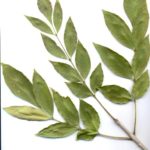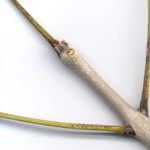green ash (Fraxinus pennsylvanica)
Family: Oleaceae
Categories |
Images |
|---|---|
| Form:
Small to medium sized tree reaching from 30 to 50 ft. in height and 20 in. in width. Irregular shaped crown with a poorly formed trunk. |
|
|
Leaves: Shape: Elliptic to lanceolate Margin: serrate Texture: Glabrous to silky above, pubescent below Variation: N/A |
|
| Bark:
Grayish brown with furrows progressing into narrow, irregular, interlacing ridges. |
|
| Twigs and Buds:
Varying from stout to moderately slender, gray to greenish brown in color. Terminal buds are conical to ovate with a rusty brown pubescence. Lateral buds are reniform to triangular in shape. |
|
| Flowers and Fruit:
Flowers before leaves appear. Male and female are both borne in glabrous to tomentose panicles. Samara as a fruit. |
|
| Distinguishing Characteristics:
Pinnately compound with 7-9 leaflets, serrate, samara as fruit, twig flattened at the nodes. Bud sits on top of the leaf scar. Usually found on moist sites. |
|
| Range:
Eastern U.S. to Canada and the northern Great Plains. |
|
| Silvics:
Intermediate tolerance. Moist bottomlands, stream side species. Once established can survive on dry sterile soils, adaptable to the extremes of climate. |
|
| Ecological and Cultural Importance:
High strength, hardness, high shock resistance, and excellent bending properties, allow it to be used in specialty items such as tool handles and baseball bats. Popular as a shade tree in residential areas due to its good form, adaptability to a wide range of sites. The seeds are browsed by a number of game and non-game animals. |



